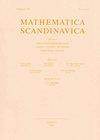Gap type results for spacelike submanifolds with parallel mean curvature vector
IF 0.7
4区 数学
Q4 MATHEMATICS
引用次数: 0
Abstract
We deal with $n$-dimensional spacelike submanifolds immersed with parallel mean curvature vector (which is supposed to be either spacelike or timelike) in a pseudo-Riemannian space form $\mathbb L_q^{n+p}(c)$ of index $1\leq q\leq p$ and constant sectional curvature $c\in \{-1,0,1\}$. Under suitable constraints on the traceless second fundamental form, we adapt the technique developed by Yang and Li (Math. Notes 100 (2016) 298–308) to prove that such a spacelike submanifold must be totally umbilical. For this, we apply a maximum principle for complete noncompact Riemannian manifolds having polynomial volume growth, recently established by Alías, Caminha and Nascimento (Ann. Mat. Pura Appl. 200 (2021) 1637–1650).具有平行平均曲率向量的类空子流形的间隙型结果
我们在指标$1\leq q\leq p$和恒定截面曲率$c\in \{-1,0,1\}$的伪黎曼空间形式$\mathbb L_q^{n+p}(c)$中处理含有平行平均曲率向量(假定为空间或时间)的$n$维类空子流形。在无迹第二基本形式的适当约束下,我们采用了Yang和Li (Math。注100(2016)298-308)证明这种类空间子歧管必须是完全脐带的。为此,我们应用了最近由Alías, Caminha和Nascimento (Ann)建立的具有多项式体积增长的完全非紧黎曼流形的极大值原理。Mat. Pura apple . 200(2021) 1637-1650)。
本文章由计算机程序翻译,如有差异,请以英文原文为准。
求助全文
约1分钟内获得全文
求助全文
来源期刊

Mathematica Scandinavica
数学-数学
CiteScore
0.60
自引率
0.00%
发文量
19
审稿时长
>12 weeks
期刊介绍:
Mathematica Scandinavica is a peer-reviewed journal in mathematics that has been published regularly since 1953. Mathematica Scandinavica is run on a non-profit basis by the five mathematical societies in Scandinavia. It is the aim of the journal to publish high quality mathematical articles of moderate length.
Mathematica Scandinavica publishes about 640 pages per year. For 2020, these will be published as one volume consisting of 3 issues (of 160, 240 and 240 pages, respectively), enabling a slight increase in article pages compared to previous years. The journal aims to publish the first issue by the end of March. Subsequent issues will follow at intervals of approximately 4 months.
All back volumes are available in paper and online from 1953. There is free access to online articles more than five years old.
 求助内容:
求助内容: 应助结果提醒方式:
应助结果提醒方式:


